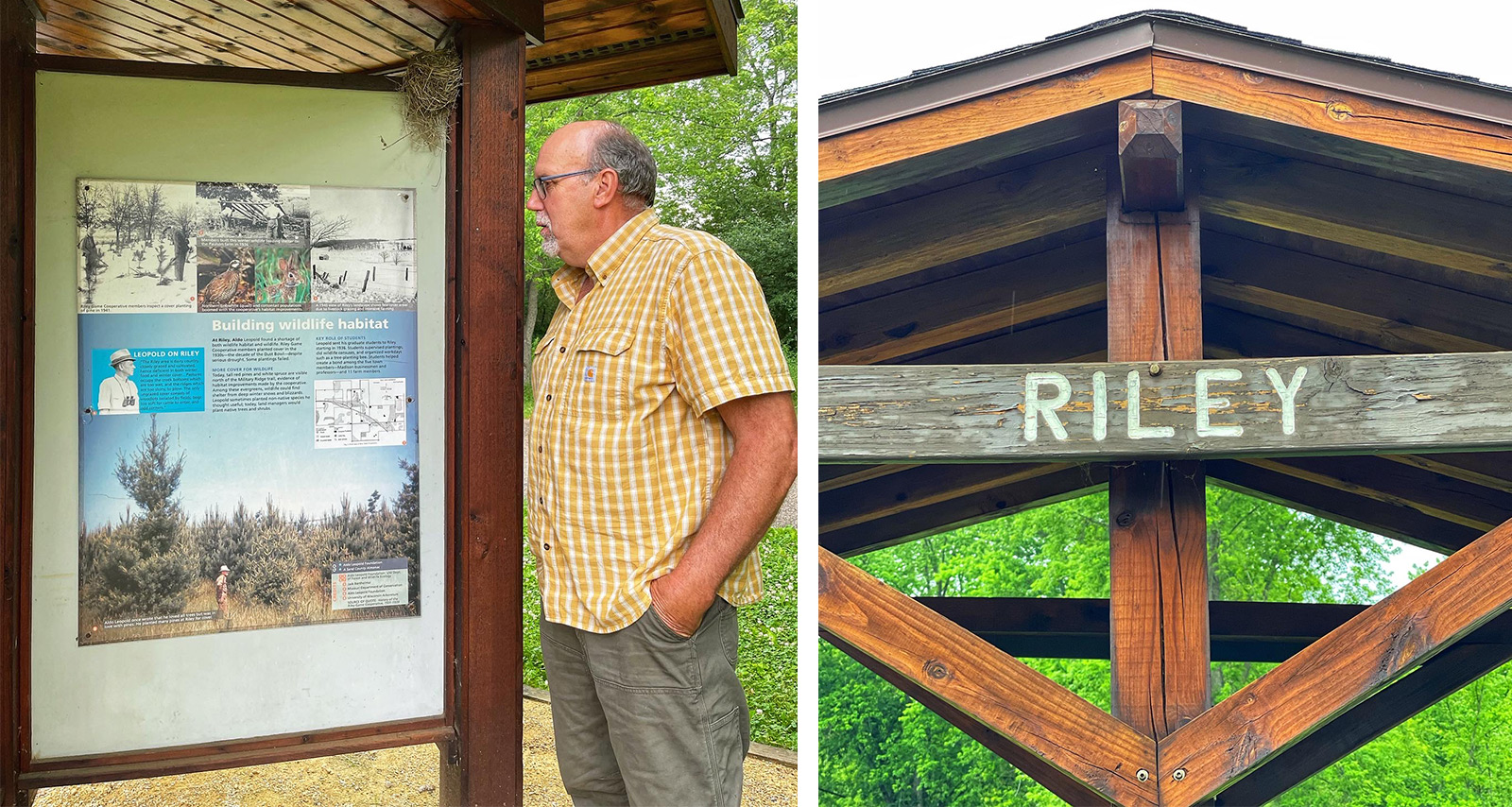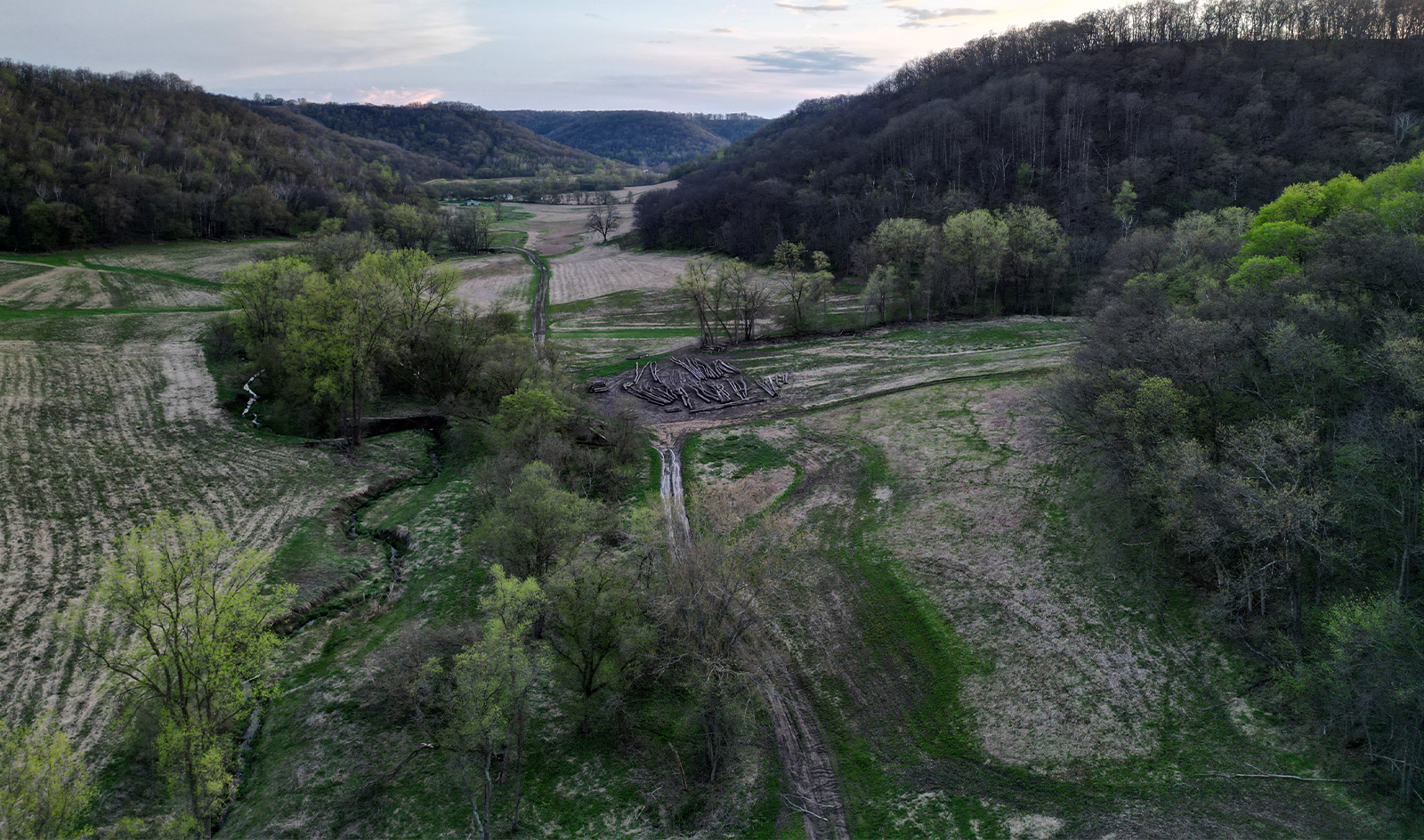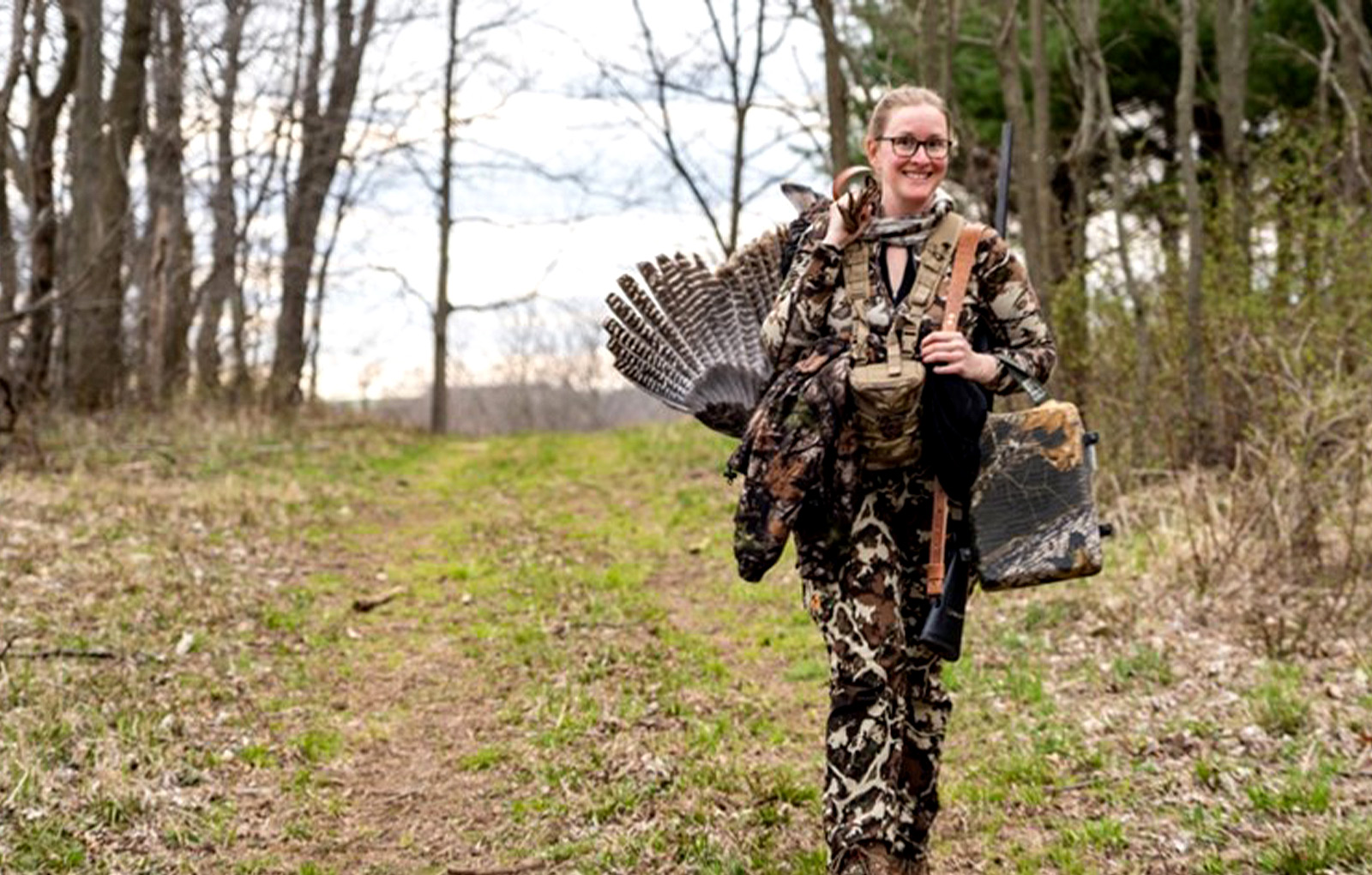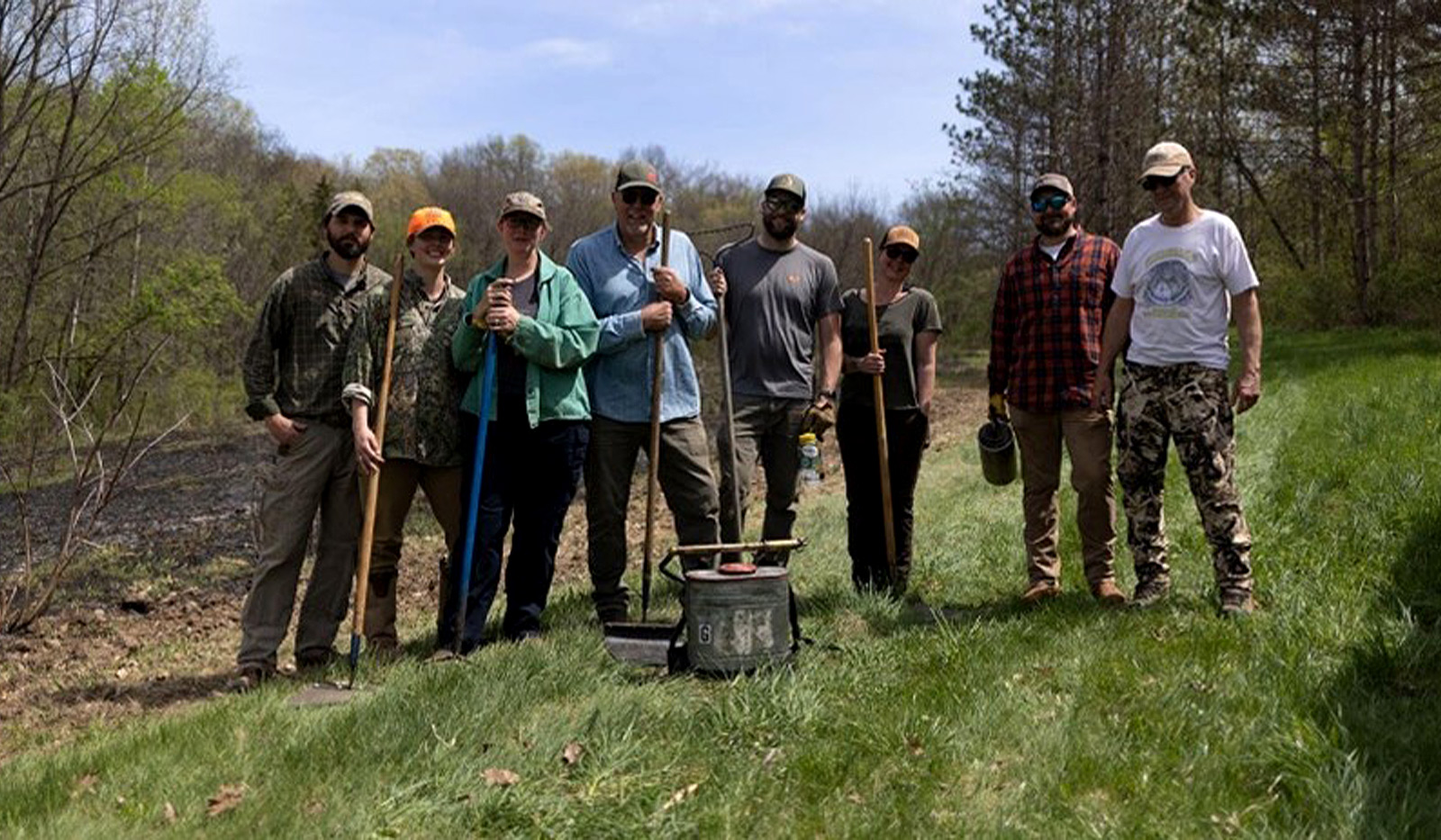A Modern-Day Example of Sharing the Land
By Doug Duren, Sharing the Land
Riley, a once thriving rural town in Southwest Wisconsin, is a crossroads where public and private land conservation history meet.
The Military Ridge Trail
The town of Riley is located on the Military Ridge Trail. Stretching 40 miles across Dane and Iowa counties, the trail was first a Native American footpath, then a wagon road established by early Wisconsin settlers and soldiers to connect pioneer forts. In the 1880s a railroad was established along the route and like many small railroad lines, became obsolete as trucks and automobiles became the main modes of transportation. In the early 1980s, the Wisconsin Natural Resources Board approved the purchase of the abandoned railroad line. The Wisconsin Department of Natural Resources developed the “rails to trails” public land trail that today is used for bicycling, hiking, snowmobiling, and cross-country skiing.
Aldo Leopold and the Riley Game Cooperative
At the Military Ridge Trail access parking lot near the Riley Tavern, the last remnant of the town Riley, a kiosk pays homage to another story of forward-thinking, conservation access: The Riley Game Cooperative.

During the years 1928-1933 Aldo Leopold, the Father of Wildlife Ecology and Conservation, was living in Madison, Wisconsin, and was conducting research for his report “Game Survey of the North Central States” which informed his thinking and led to his seminal work on wildlife management “Game Management.” Leopold, who had not yet purchased the run-down farm and shack made famous in his posthumously published book “A Sand County Almanac,” stumbled upon the town of Riley in 1931 while on an expedition searching for a new place to hunt. There he met a local farmer, Reuben Paulson. Leopold later described the event:
“One Sunday in 1931, I was cruising western Dane County, looking for a place to hunt during the approaching season. I stopped at the farmyard for a drink of water. The farmer, Reuben Paulson, was washing milk cans at the well. We talked game. He needed relief from trespassers who each year poached his birds despite his signs; I needed a place to try management as a means of building up something to hunt. We concluded that a group of farmers, working with a group of town sportsmen, offered the best defense against trespass, also the best chance for building up game. Thus was Riley born.”
Aldo Leopold, 1940, in History of the Riley Game Cooperative, 1931-1939, Journal of Wildlife Management
With the cooperation and contributions of other Riley farmers and Leopold’s friends and students from the Madison area, the Riley Game Cooperative was formed. This partnership between the farmers and townspeople served as a way for Leopold and his hunting friends to work with the farmers and their families and contribute labor and resources to habitat improvements and conservation efforts. Not only did the group share in the work and the hunting, but it was a way to socialize and build a community of like-minded people. The Riley Game Cooperative operated throughout the 1930s and 40s and became an outdoor classroom when Leopold joined the faculty and established the now-named Wildlife Ecology Department at the University of Wisconsin-Madison. The cooperative continued after Leopold’s death in 1948 until the early 1960s.
Leopold’s “Game Management” and “Something New Must Be Done”
In 1933 Leopold published “Game Management,” and along with his position at UW Madison, established the discipline of Wildlife Ecology. Along with the Riley Game Cooperative, it was the beginning of his call for caring for the land and by extension, all the members of the biotic community that inhabit it.
I became aware of Aldo Leopold when I was in high school and his book, A Sand County Almanac fascinated me then and continues to speak to me 50 years later. As a farm kid, growing up in rural Wisconsin, I lived a youth that included much of what Leopold wrote about in the first part of the book. That little book, especially the last two sections, continues to speak to me today.
In the late 1990s, I became this generation’s steward on our family farm near Cazenovia, Wisconsin. Located 60 miles north of Riley and 30 miles west of Leopold’s farm and shack, the 400-acre property owned by my family 120 years has evolved over time from a source of timber for my forefather’s sawmills, into a quintessential Wisconsin Dairy farm, to now a conservation-based legacy property. Although managing the property could be a full-time job, it’s difficult to squeeze a full-time paycheck from it. Add to that I am the owner of a small business and up until a few years ago, my wife and I lived in Madison, 65 miles away. I, like many modern rural landowners, was an absentee owner and steward, working on projects on weekends and squeezing in hunting when I could.
Over the past 30-40 years, the small working farm has pretty much disappeared from the rural landscape, and land practices and ownership have changed. Populations of whitetail deer and turkey exploded. Landowners plan and implement management strategies to care for their land. Land ownership is a time-consuming participation sport! At the same time, hunting and other access to private land has become more difficult for outdoors people to secure. As a manager of our family and through my land management business, I experienced these issues and opportunities firsthand and pondered ideas.

Leopold, musing about similar issues in the 1930s said, when musing about private land conservation, “Something new must be done”. In the early 2000s, I found out about one of his “new” ideas. I was bicycling along the Military Ridge Trail with a friend, when we stopped in Riley for refreshments. A new kiosk had been erected which provided information about the trail and the area. I went over to check it out and there I was introduced to the Riley Game Cooperative.
The idea that hunting can be cooperative, an experience shared with family and friends, was familiar to me. My father, who was my first and most influential hunting mentor, had stressed how “hunting with and for the other guy” made the experience more enjoyable and productive. Leopold had taken that idea and added the shared experience of conservation education and action. I had grown up with the ethic of helping neighbors and friends with chores and that community and cooperation extended to our outdoor experiences. Was “Something New” simply revisiting those ideas and applying them to the 21st century?
The Duren Farm, Sharing the Land, and Leopold’s Five Tools of Wildlife Management
As I reflected on the current situation in the outdoor world, the work that needed to be done on the farm and discussing Leopold’s experience and lessons with some like-minded friends, we decided to see if we could create something that brought it all forward. Sharing the Land, a conservation cooperators network, connecting landowners with hunters and access seekers has evolved out of all that history and thought. The premise is simple: Access to private land has value; the land needs us to care for it; anyone interacting with the land should be willing to contribute to conservation; relationships, cooperation, and community give us the opportunity to be part of something bigger than just taking from the land.
The Sharing the Land website provides a meeting place for people interested in making those kinds of connections and contributions and bartering for access. Landowners fill out a Cooperating Land Profile where they describe their property, their interests, needs, and available access opportunities. Access Seekers fill out a Conservation Resume where they provide information about themselves and their interests, skills, and willingness to contribute. Sharing the Land staff receives this information and matches landowners and access seekers. Other resources such as agreement forms, insurance offers, and other FAQs are offered to all involved.

Launched in 2022, Sharing the Land has 25 Cooperating Land properties enrolled in seven states and over 300 Conservation Resumes submitted. Landowners and Access Seekers are being matched and although demand outpaces supply, there have been a lot of connections and successes.
In Game Management Leopold taught, “The central thesis of game management is this: Game can be restored by the creative use of the same tools which have destroyed it—axe, plow, cow, fire, and gun.”
Sharing the Land Cooperating Landowners and Access Seekers are using those tools as they work together on projects and access. Here are some examples:
The Axe (Chainsaw, Handsaw, and Loppers)
“We teamed up with Kevin and thus far it seems to be working out well. He is a friendly, talkative guy and has come out to the farm on three different occasions. The first trip was just to get to know each other and tour the farm. On the second and third trips, we worked together with him on some brush/tree cutting and building wood piles. Because he wanted to know at the outset what we expected of him in exchange for hunting access, we worked out a plan under which he would help us do various tasks around the farm over the course of the spring/summer/fall. Kevin seems happy with the arrangement, and we are enjoying having some help at the farm.” – Mary, landowner
“Things are going great! Took us a while to get together but we’ve had two great workdays so far and the property is stunning! Looking forward to learning more about the property, helping out, and of course the Fall hunting season!” – Kevin, access cooperator
Plow (and the Tree Planter)
“Dear Ashley, I wanted to follow up with our Sharing the Land Project. You did a great job! Thank you for your work and for working with others so well. We planted 200 berry-producing trees (of six different varieties) and weeded 2000 others. Good teamwork, we got it all done in one day! You also have two beautiful dogs. They were very well-behaved, and I enjoyed watching them run and work. You will have many years of joy with them. As we agreed, for the summer and for the entire hunting season of 2023 through January 31, 2024, you have my permission to access and hunt on my farm.” – Gordy, landowner
“Our first meeting was in late April, while the harsh remnants of the winter were melting away, and I saw the plan for his property. This included removing invasive wormwood from a wildlife buffer that had been planted in the last few years. Trees and shrubs were carefully selected for their foraging and protection qualities for resident animals. One month later, seven eager volunteers who also signed up through the program went straight to work on making way for new plantings and give existing trees room to breathe by pulling the wormwood. Working together made it easy to conclude all of Gordy’s plans in just one day.” – Ashley, access cooperator.
The Cow (and the Goat)
“We started over 20 years ago with our first wildlife habitat project. In our part of the state, winter thermal cover and brood habitat are key for upland bird survival. Our habitat improvement efforts have focused on mostly thermal cover plantings consisting of shrubs and trees. Over the past few years, we have added pollinator and food plots and started rehabilitating 80-year-old shelterbelts. We are now working on native grass re-establishment, grazing management practices for our pastures and “right-sizing” grazing cells, providing fresh water sources for cattle, and protecting cattail drainage areas from cattle. As you may imagine, all this is a lot of work. From fencing removal, new fencing installations, maintaining fence, installing water pipe, removing old tree rows, prepping for, and planting new tree rows, replacing failed tree plantings, and controlling invasive species – it’s become a full-time job for a couple months in the spring. The Access Cooperators are enthusiastic, and the work goes quickly and enjoyably. We’re happy to provide access to folks like this who are willing to help us with these projects.” – Kurt, landowner
“I went well, quick work with all the help. Beautiful evening on the prairie. He has some beautiful pieces of property, and the family was very welcoming. My daughter even got in on the work a little, which is good for her to understand that habitat doesn’t just happen.” – Rachel, access seeker

Fire: Prescribed Burn
“I have always wanted to use fire more as a management tool, but because I’m not really experienced with it and need a lot of help to do it safely, I usually opted for the mowing option for managing native areas. With the knowledge of some of my cooperators and having plenty of a turkey hunting group around to assist, we burned three areas safely and effectively. It was a very successful day and there was plenty of time to hunt!” – Doug, landowner
“The beauty of the model lies in engagement. Once an access-seeker invests in the stewardship of a property, they gain a heightened connection to it, and become incentivized to enhance the health and productivity of the encompassed resource. They are given the gift not just of deer or birds to hunt or trout to catch, trails to hike, or birds to watch, but the more holistic gift of a sense of place. The landowner in turn benefits both from the improvements, and from the strength of those relationships built.” – Reid, access cooperator, and landowner
“It was gratifying to lend my experience with prescribed fire to the crew. What a great day. I can’t express how much fun this has been. Thank you so much for letting us be a small part of what you are doing!” – Mark, access cooperator
Gun: Hunting and Foraging
“As a part of Sharing the Land, I had the opportunity to learn how to hunt in a safe, supportive environment, with the best mentors imaginable. At the same time, I was encouraged to develop a relationship with the land I was harvesting from, something that was extremely important to me. I would have never felt comfortable as a new hunter asking for permission to hunt on someone else’s land, and I would have never felt comfortable going out on public land alone for my first gun hunt. But Sharing the Land is not about gaining permission, it’s about community.” – Megan, access seeker
The Future of Access and Conservation
It’s a common refrain amongst some in the outdoor community “I remember in the good old days, when you could just hunt wherever you wanted or knock on a door and get access”. That may have been true, but everything changes. Let’s ask ourselves “What can I do to be a good land steward and contribute to conservation?” Let’s build our conservation resumes and make this land better than it was. Let’s applaud landowners who meet and grant permission access seekers willing to put in some sweat equity to help the land. These are our good old days. Let’s make sure that the next generations also have them. Let’s remember, “It’s not ours, it’s just our turn.”